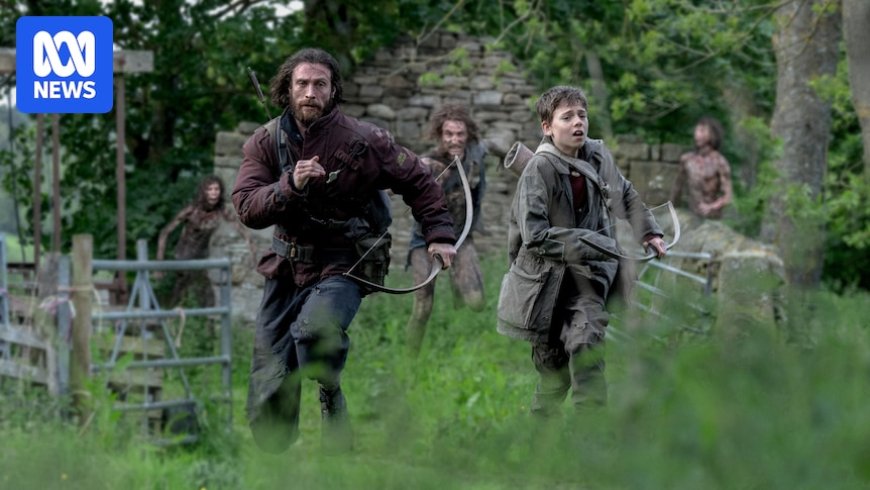Danny Boyle Returns with '28 Years Later' Sequel to '28 Days Later'
In '28 Years Later', a 12-year-old ventures into zombie-infected Britain. Starring Alfie Williams, Jodie Comer, Aaron Taylor-Johnson. Directed by Danny Boyle. The film offers a fresh take on the zombie genre with fast-paced action and emotional depth. Now showing in Australian cinemas.

It hasn't quite been 28 years since a bleary-eyed Cillian Murphy drifted onto the streets of a deserted London, in 2002's 28 Days Later, which redefined the zombie film for a new millennium.
Fast facts about 28 Years Later
What: A 12-year-old member of a secluded island community ventures into zombie-infected Britain.
Starring: Alfie Williams, Jodie Comer, Aaron Taylor-Johnson
Directed by: Danny Boyle
Likely to make you feel: Like the wait was worth it
Danny Boyle and screenwriter Alex Garland flooded Britain with a 'rage virus' that evolved the undead from a shuffling, slow-burn threat into a frenzied foe. Its frenetic editing and MiniDV cinematography established the visual hallmarks for a paranoid era of post-9/11 horror.
The timing of the film's sequel, 28 Years Later, now in Australian cinemas, feels apt.
Zombie films have found major commercial success in recent decades but, creatively, they've stalled.
The fast zombies and gritty survivalist narrative of Boyle's original film have been endlessly recycled. It's telling that the most popular example of the genre, HBO's The Last of Us, is an adaptation of a 2013 video game.
If the apocalypse was a fun hypothetical to consider in the early 2010s — the peak of zombie saturation — the pandemic has made societal collapse a more immediate reality.
Boyle, now 68 years old, has lost little of the apoplectic fury that charged his pioneering classic.
28 Years Later begins on a secluded island whose inhabitants have successfully weathered the few decades since the rage virus broke containment. The fortified community is connected to mainland Britain via a low-lying coastal path, where villagers go to gather resources — and, in the case of 12-year-old Spike (Alfie Williams), score a first infected kill.
As part of his coming-of-age rite, Spike's father, Jamie (Aaron Taylor-Johnson, Nosferatu), accompanies him for his first encounter with the undead. Their mission quickly goes sideways when they encounter an Alpha, a mutated variant with colossal strength and a pack of underlings under command.
The mainland is also revealed to be home to Ian Kelson (Ralph Fiennes, Conclave), a doctor branded as a madman by the villagers for his unconventional handling of the undead but, potentially, the only hope for Spike's mother, Isla (Jodie Comer, Killing Eve), whose mind and body have been wracked by a mysterious disease.
The first stretch of the film is an effectively nervy exercise in folk horror but it's not immediately clear why, after so many years, Boyle and Garland decided to revisit this world.
Save for some flashes of clever world-building (the village being comprised of die-hard Queen Liz royalists is a bleakly hilarious touch), the expanded scope of 28 Years Later initially stays confined to well-trodden genre territory. Cultish enclaves are a persistent rash in the post-apocalypse, while the virus's Alpha mutation is a cliché better suited to video games. One of the early surprises is that, with the scarcity of human flesh, some of the sprinting zombies of yore have now been reduced to a crawl.
The transition from MiniDV's hypnotically hazy textures to iPhone cinematography makes for an intriguing stylistic refresh, if not a revolutionary one.
In the hands of returning DP Anthony Dod Mantle (who steered the early digital innovations of the Dogme 95 movement), the iPhone 15 Max footage lends an eerie unreality to the film, visible in its deep focus, wide angles and sharp edges, the horizon hanging oppressively across the overgrown landscape. Unlike a typical phone recording, the image is stretched into a panoramic aspect ratio (usually reserved for Hollywood epics), while colours are intensified into irradiated hues.
It's an astonishing advertisement for what consumer electronics are capable of nowadays, though the film resists some of the more idiosyncratic limitations of pocket cameras. There's a noticeable shift away from its scrappy, low-budget origins, with the occasional use of drones and expensive cinema cameras adding an additional sheen to its exterior.
The human story of 28 Years Later is surprisingly compelling in its own right and, unlike the broader expansion of this world, is kept satisfyingly contained. Fiennes utterly commands the third act of the film with a unique take on Dr Kelson's enigmatic, Kurtz-like figure, whose towering monuments to death comprise the film's most striking imagery.
If rage fuelled the early days of the virus outbreak, grief is now the guiding light through its long-term ravages. Amid the exorbitant displays of brutality, death is treated with an unexpected tenderness that raises 28 Years Later to new emotional heights within the genre.
After a character has their spinal cord ripped from their body, we observe in great detail as their head is thrust into a kiln, scrubbed free of its charred scalp, and washed. You'll have to trust me when I say it's one of the most beautiful things I've ever seen.
28 Years Later is in cinemas now.
What's Your Reaction?
 Like
0
Like
0
 Dislike
0
Dislike
0
 Love
0
Love
0
 Funny
0
Funny
0
 Angry
0
Angry
0
 Sad
0
Sad
0
 Wow
0
Wow
0





















































































































































